
In this guide:
A history of gemstones

Gemstones have been a part of human culture for thousands of years. While empires rise and fall, fashions change and technology continues to evolve, the alluring draw of colourful, rare and precious gems has remained a constant in our global society.
Coveted by rulers and common folk alike, gemstones dazzle and delight with their radiant glow. As far back as the history books can chart, gems have found a place in the texts and scriptures of countless societies. Let’s track where that all began, as well as exactly what it is that earns a mineral the title of gemstone.
What is a gemstone?
Gemstones are minerals, rocks, or organic matters that have crystalline properties. Owing to their colourful and iconic look, gems have been used to adorn clothing and artwork for millenia. Perhaps most common of all, gemstones are an intrinsic part of both archaic and contemporary jewellery.
This is far from their sole purpose, however. Gemstones can be used to decorate and add a sense of grandeur to almost any item, with artefacts such as combs, plates, ceremonial objects and even weapons found covered in them.
While the popular belief is that all gemstones are mined from the ground, this isn’t always true. Amber and pearl are good examples of gems which possess immense value but come from sources other than underground.
In total there are believed to be as many as 315 different types of gemstones in existence. These gems can be found in every colour imaginable, with some even being classed as “colourless” altogether. These colours are determined by unique chemical and atomic structures in the genetic makeup of the stone.
Of these 315 gemstones, only four are given the official title of “precious”:

Diamond

Ruby

Emerald

Sapphire
All other gems are categorised as “semi-precious” — although this doesn’t mean they don’t still carry tremendous financial value. These core four gems are seen as more valuable because of their quality, rarity and the beauty of their colour.
Origins of gemstones
Most gemstones can trace their lineage back millions or billions of years. The oldest gemstone is believed to be Zircon, whose origins may extend as far back as 4.4 billion years ago.
Diamonds, by contrast, are ‘just’ 3 billion years old, while sapphires were formed 150 million years ago. The formation process itself is simple, but can take years to finalise. Combining immense heat, pressure, time, and mineral deposits, gems are either created by the cooling of mineral-rich hydrothermal water, or as a transformational byproduct of rock cultivation in the Earth’s crust.
It might surprise some to learn that not all gems have their origins on our planet. Peridot is a lime green crystal which has been found on interstellar asteroids. Scientists believe the gemstone was created during the events of the Big Bang — which could make it one of the earliest known substances in the history of creation.
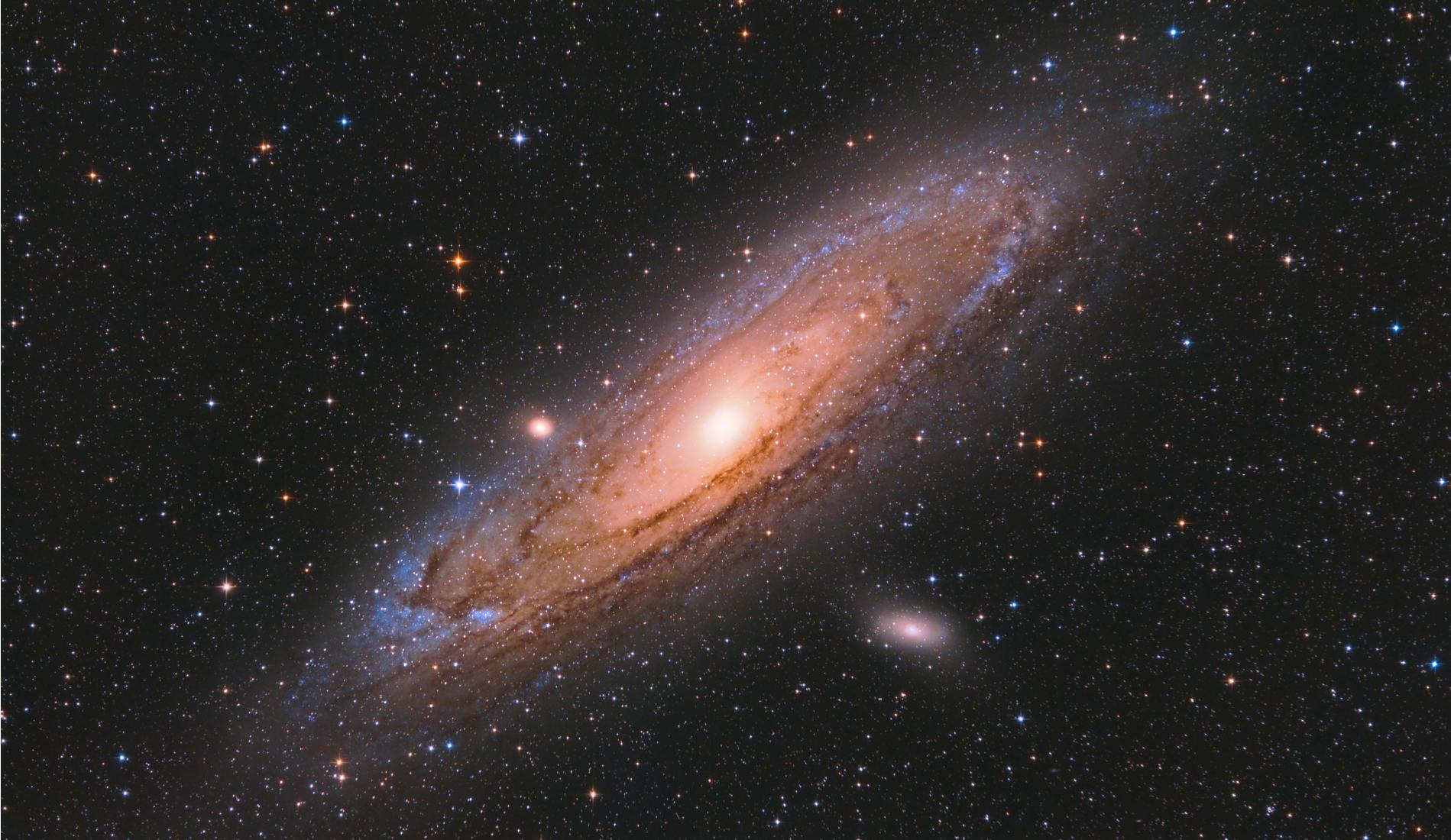
The early uses and meaning of gemstones throughout time
While human history is very new in the wider sphere of time, there have already been countless examples of gemstones being used throughout the ages by several cultures. With an importance placed on gems which goes as far back as the beginning of recorded history, it’s little surprise that they continue to hold a special place in contemporary society.
Let’s now take a closer look at the lineage of some of the most popular and best known gemstones, as we delve into their significance and origins.

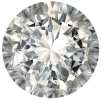
Diamond
Colour
Multi-coloured
Rarity
Precious
Popular cuts
Round brilliant, Cushion, Princess, Emerald, Oval, Pear
Such has been the importance of diamonds through the ages, that in the first century AD Roman naturalist Pliny would scribe “Diamond is the most valuable, not only of precious stones, but of all things in this world.”
The first recorded mention of diamonds dates back to India in the 4th century BCE. These shiny minerals were believed to only exist in India until 1725, when a small deposit of the gems was found in a pocket in Brazil. Since then, further discoveries have been made in Australia, Botswana, Canada, China, Congo, Russia and South Africa.
Perhaps the most defining legacy that diamonds left on the world was the Silk Road. This trade route from China to India was the centralised transportation method of gemstones for centuries.
Throughout the ancient world, diamonds were used for a number of purposes, extending beyond jewellery alone. They also served the practical purpose of a cutting tool, as well as talismans to ward off evil and provide protection for a loved one in battle.
The diamond landscape would change forever in 1866, with the discovery of the world's largest diamond pocket in Kimberley, South Africa. The pocket found here now accounts for up to 90% of the world’s total distribution.
The first recorded mention of diamonds dates back to India in the 4th century BCE

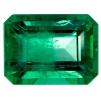
Emerald
Colour
Green
Rarity
Precious
Popular cuts
Emerald
In the immortal worlds of Pliny, “nothing greens greener”. As one of the four core precious gemstones, emerald has long epitomised this particular colour, and lends its name to several iconic objects and locales. The Emerald Isles (Ireland), Emerald City (Seattle), and even the Emerald Buddha of Thailand (which is ironically made of jade) are all world-renowned names which can be traced back to the mineral.
Incas were amongst the first to bask in the splendour of its green glow, with jewellery adorned with the precious stone common amongst the wealthy. When Spanish conquistadors arrived on their shores, the gems were traded away in favour of precious metals like gold and silver. The traded emeralds would usually land in the laps of European and Asian royalty, who believed that, if placed under the tongue, the stone would grant them protection against evil spells and help them see the future.
Other symbolic traditions associate emerald as a cure for diseases like cholera and malaria, while some believed it had the power to reveal the legitimacy of a lover’s oath. In modern culture emerald has become synonymous with 35th wedding anniversaries.
The first known gems were mined in Egypt from at least 330 BCE. Cleopatra herself was even said to have a penchant for them. The three major sources of emerald mining today are Zambia, Colombia and Brazil.
Incas were amongst the first to bask in the splendour of its green glow, with jewellery adorned with the precious stone


Ruby
Colour
Red
Rarity
Precious
Popular cuts
Cushion and Oval
Defined by their fiery red glow, rubies are another of the core four gemstones which have played a special role in several cultures throughout the ages. The ancient language of Sanskrit refers to ruby as ratnaraj, or ‘king of precious stones.’ This association with royalty transcends most cultures — ancient Hindus believed offering high-quality rubies to the god Krishna would see one reincarnated as an emperor in their next life.
Other Hindu meanings for the gem include a spiritual association with safety, as well as living in peace with one’s enemies. In Burma, warriors used rubies to make themselves invincible in battle. Fascinatingly, these warriors wouldn’t just carry rubies on them, but would insert them into their flesh.
In Medieval Europe, this red gemstone was a sign of wealth, and would be commonly seen on ceremonial robes and jewellery. They were also considered a symbol of health, wealth, wisdom, and success in love. The latter persists to this day, and is used as the traditional gift for a 40th wedding anniversary.
Mining of rubies first began in Myanmar (then known as Burma) in 2,500 BCE, but has since expanded to all corners of the globe, with the likes of Afghanistan, Australia, Cambodia, India, Madagascar, Malawi, Mozambique, Pakistan, Sri Lanka, Tanzania, Thailand, the United States, and Vietnam all possessing at least one site.
In Medieval Europe, this red gemstone was a sign of wealth, and would be commonly seen on ceremonial robes and jewellery

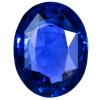
Sapphire
Colour
Blue and multi-coloured
Rarity
Precious
Popular cuts
Round, Oval and Princess
This brilliant blue gemstone (another of the core four) has long been associated with the heavens, owing to its royal colour. In ancient Persia, for example, it was believed the world rested on a giant sapphire and that its reflections gave the sky an evenly blue colour. This connection to the gods would be brought to the forefront in Ancient Greece, where those seeking answers from the Oracle of Delphi would wear sapphires to ensure their questions were answered correctly.
In Buddhist culture, sapphires were said to bring enlightenment, while Hindus regularly used these beautiful gemstones to appease their gods during periods of religious worship. In perhaps the most famous example of their use in classical history, it’s believed by some that the Ten Commandments were engraved on slabs of sapphires.
First discovered in Persia (modern day Iran) around 800 BCE, sapphires remain a prominent feature of Middle Eastern and East Asian mining culture. Kashmir became the home of most sapphire mining projects in the 19th and 20th centuries, with Madagascar taking up the mantle in the 1990s.
In recent years, the gemstone has become a symbol of “royal love” amongst the British monarchy, with the then-Prince (now King) Charles giving his former wife Lady Diana Spencer a 12-carat blue sapphire ring in 1981. His son, Prince William, would continue the tradition when he gave this ring to Kate Middleton in 2010.
First discovered in Persia (modern day Iran) around 800 BCE, sapphires remain a prominent feature of Middle Eastern and East Asian mining culture


Agate
Colour
Dark red, orange, grey or brown
Rarity
Semi-precious
Popular cuts
Pear and Brilliant round
Named after the Achates river in Sicily, this iconic gem first came to the forefront as far back as 300 BCE, when it was discovered in the riverbed there. In the age of Julius Caesar, the Romans would also find the gemstone in a body of water — this time the Nahe River in Germany. The gem-cutting facility which was set up alongside the banks of this site are still in operation to this day.
Ancient Egyptians wore grey agate around their necks to protect and heal this part of their body, while the Romans themselves would use the gem as part of medicinal routines to improve their general disposition and help fix bad eyesight.
For the Persians, agate was the remedy for breaking a fever. The gems were placed inside the mouth to combat thirst and reduce temperature. In Saxon culture, agate was said to prevent harm from thunder, sorcery, demonic possession, poison and even drunkenness.
During the reign of Queen Victoria, Scottish agate would rise to prominence amongst the wealthy of the day. These shows of decadence are now highly coveted by contemporary jewellery collectors.
Agate can be found across most of the world today, but is perhaps most commonly mined in the United States. Deposits of the gemstone are regularly unearthed in Oregon, Washington, Idaho and Montana.
Ancient Egyptians wore grey agate around their necks to protect and heal this part of their body

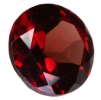
Garnet
Colour
Red, green, pink and yellow
Rarity
Semi-precious
Popular cuts
Brilliant, Round and Square
As durable a gemstone as they come, this colourful stone has been traced back as far as the Bronze Age, with several references also tying it to life in Ancient Egyptian culture. The gem was used as a talisman for warriors going into battle, and would be used to ward off the threat of pestilence or plague.
In extreme cases, Roman healers would sew garnet stones into the wounds of those who’d been injured, believing it would cleanse and protect against any potential disease. It’s unknown if this had the desired effect or not.
In jewellery, garnets were used as signet rings throughout most of the Roman World, and would persist as such through the Middle Ages. The gem grew increasingly popular during the Victorian age, often used as a collage to create larger objects — most notably pomegranates, whose Ancient Greek name of “granatum” is what gave the gem its title.
Garnet was first discovered in the Nile Delta, around 3,100 BCE. Today, mining operations exist in all corners of the globe, with projects currently underway in Russia, China, India, Australia, Canada, Brazil, Zambia, Kenya, Nigeria, Tanzania, South Africa and the United States.
In extreme cases, Roman healers would sew garnet stones into the wounds of those who’d been injured


Jade
Colour
Green
Rarity
Semi-precious
Popular cuts
Pear and Oval
When we think of jade, most of us associate this vibrant green gemstone with the world of imperial ancient China. For more than 3,000 years, palaces across several dynasties were decorated in this beautiful shade, with intricate carvings and ceremonial objects proudly displayed as a symbol of power.
This practice of carving jade was far from just an aesthetic addition to the home in the centuries prior. Stone age workers would commonly carve weapons and tools out of the material, thanks to its tough nature. Even for more practical uses, the craftsman still appreciated this gemstone’s power — believing it to invoke the mystic forces of heaven and Earth.
In Central America, the Mayans and Aztecs used jade for medicinal purposes. This is where the name “jade” derives from, with Spanish conquistadores naming it “piedra de ijada” — translating to “stone of the pain in the side”, after they saw several natives holding the green gem to the side of their bodies to cure ailments.
Modern jade carvings are still popular in China, with the most common motifs all carrying with them a symbolic meaning:
- Bat — happiness
- Butterfly — long life
- Dragon — power, prosperity, and goodness
- Peach — immortality
- Bi (flat circular disk with a hole in the centre) — heaven
Myanmar, New Zealand, Canada, Taiwan, Guyana, Surinam, southern Europe, Russia and China are the most common sources of jade mining today, with the most notable early locales being the Ningshao area in the Yangtze River Delta (Liangzhu culture 3400–2250 BCE) and in an area of the Liaoning province and Inner Mongolia (Hongshan culture 4700–2200 BCE).
Stone age workers would commonly carve weapons and tools out of the material, thanks to its tough nature

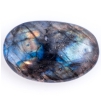
Labradorite
Colour
Blue and black
Rarity
Semi-precious
Popular cuts
Brilliant round, Oval and Pear
Taking its name from the nearby town of Labrador on Paul Island in Eastern Canada, this majestic stone is loved the world over for its synergy with the Northern Lights. The unique kaleidoscope of this primary black and blue gem gives labradorite a celestial quality, making it an intrinsic part of cultural folklore for generations.
Most poignantly of all, the Inuit and Beothuk people of the local region would use the gem as a healing tool, with the belief that it would also bring good mental health to those who possessed it. It’s also believed that finding the gemstone in its natural form is a precursor to efficiently managing a period of trouble or strife in your life.
Despite being so closely associated with Canada, labradorite can be found in pockets all across the world. Current deposits are mined in Poland, Norway, Finland, Madagascar, China, Australia, Slovakia and the United States.
The unique kaleidoscope of this primary black and blue gem gives labradorite a celestial quality


Lapis Lazuli
Colour
Blue
Rarity
Semi-precious
Popular cuts
Pear, Oval, Round and Emerald
While less commonly spoken about in contemporary annals, lapis was once one of the prize gems of the ancient world. Ancient civilisations like Mesopotamia, Egypt, China, Greece, and Rome all coveted this luscious ocean blue gem — which was once valued as highly as sapphires.
Egyptians believed that rubbing lapis powder in the eyes would improve eyesight. It was also seen as a symbol of royalty, strength and courage, wisdom and intellect, friendship and truth throughout most of the classical age.
The versatility and durability of the mineral has meant that hundreds of lapis objects from classical antiquity still exist today. Among them are rings, tablets, ornamental carvings, brooches, and several examples of fine jewellery.
Origins for lapis stretch back to modern-day Afghanistan — then known as Bactria. In what is believed to be the first example of a commercial mining project, workers in 700 BCE would trek mountains rising as high as 17,000 feet to mine this exotic gem from the soil found there.
Deposits of lapis are primarily still mined in Afghanistan to this day, but other examples have also been discovered in Chile, Siberia, the United States, and Myanmar.
Egyptians believed that rubbing lapis powder in the eyes would improve eyesight


Moonstone
Colour
White or green
Rarity
Semi-precious
Popular cuts
Oval, Round and Briolette
Perhaps unsurprisingly, given this gem's ethereal name, moonstone has properties which set it apart from most of its peers. This often opaque stone will radiantly shine when light hits it, its glow seeming to come from within the moonstone itself. This mystic occurrence is referred to as adularescence.
Owing to its unique appearance, the gem has been at the forefront of folklore for generations. In Ancient Rome, it was believed the gems were solidified beams of moonlights, and thus were often used during worship of the goddess of the moon, Diana. Offering her a gem would grant love, wisdom and good fortune. It was believed that those who used moonstone in jewellery would make smart choices in life, as well as having enhanced prophetic abilities.
Indian culture also had an affinity with the gem. It was believed the moon god Chandra Shekara had one permanently lodged in the centre of his head. The gemstone was also associated with love and was traditionally offered as a gift at affluent weddings. It was also believed that if two people wearing a moonstone met on the night of a full moon they’d fall passionately in love.
Modern mining efforts are largely localised in Sri Lanka and Southern India, with some projects in Australia, Armenia, Mexico, Brazil and the United States.
Owing to its unique appearance, the gem has been at the forefront of folklore for generations

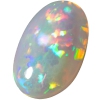
Opal
Colour
Multi-coloured
Rarity
Semi-precious
Popular cuts
Oval, Round, Pear and Marquise
The otherworldly explosion of colour which most opals possess have unsurprisingly led to them being seen in most ancient cultures as highly spiritual and symbolic items. Arabic legends believed these gems to fall from the sky during flashes of lightning, while the Ancient Greeks felt like opals guarded them against famine and disease.
In Europe, opal represents hope, purity, and truth, while in most cultures it’s considered the luckiest of all gemstones, owing to its ability to possess almost every natural colour. Furthermore, it was also believed that opals could preserve the life and colour of blond hair.
Historic records suggest the first example of mined opal stretches as far back as 10,000 years ago, with the gemstone found in Virgin Valley, North America. Slightly more recently — 6,000 years ago — the Aztecs were believed to find a pocket of the gems, while artefacts from Kenya around the same time also show their presence.
Modern mining efforts for opals can be found primarily in Australia, but is also present in Brazil, Mexico, Honduras and the western US. 95% of all opals are currently unearthed down under.
Historic records suggest the first example of mined opal stretches as far back as 10,000 years ago

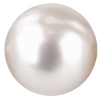
Pearl
Colour
Multi-coloured
Rarity
Semi-precious
Popular cuts
Round
Pearls have held a special place in society for millennia, with the Ancient Greeks believing they were the solidified tears of the Gods. The gem was presented to Chinese royalty as a gift as far back as 2,300BCE, while in Rome the wearing of pearls was exclusive to the ruling elites of the day.
A clear connection between the monarchy and this organically created gemstone comes from 520BC — when a Persian prince was entombed with pearls in his sarcophagus. During the Byzantine Empire strict legislation was introduced stating that only the emperor was allowed to wear the circular gem.
The association with royalty would continue through to Tudor England, which would come to be known as the “Pearl Age”, owing to the nobility of the time favouring pearls in both clothing and jewellery.
Away from these regal connections, pearls are believed to be the gemstone most associated with inner wisdom — allowing a wearer to dive deep into their own soul and gain a better understanding of themselves. Far from providing good emotional health alone, pearls are also said to have the tangible effect of increasing physical balance, particularly benefiting lung health and improving hormonal balance.
The gem was presented to Chinese royalty as a gift as far back as 2,300BCE

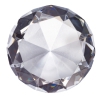
Topaz
Colour
Yellow and Multi-coloured
Rarity
Semi-precious
Popular cuts
Round brilliant, Oval and Princess
The cultural presence of topaz throughout the ages is a little more complex than most gemstones. For centuries, it was believed that all yellow stones fell under the topaz umbrella. However, modern mineralogists have determined that many yellow gems actually belong to other mineral families, making certain historical references potentially inaccurate.
Regardless, the symbolic presence of topaz has been at the heart of many cultures for millenia. When witchcraft was a genuine concern during the Renaissance period, many believed the stone could break spells and soften anger. Meanwhile, Hindus believed that topaz could bring wisdom and longevity. African shamans would use topaz in a similar way to Mayans with jade, as they believed it to have healing properties when rubbed on the body.
Today, topaz is one of the most affordable gemstones, owing to large deposits which were discovered in Brazil in the mid-19th century. Prior to this, topaz was perhaps most famously associated with the Russian Tzars. The Ural Mountains were the leading source of mining prior to the Brazilian pocket being found, but the pink-orange topaz found there could only be owned by the Russian royal family.
Modern mining efforts are found in every corner of the globe, with Brazil, the United States, Madagascar, Myanmar, Namibia, Zimbabwe, Mexico, Sri Lanka, Pakistan, Russia, and China all found to hold rich deposits of this semi-precious stone.
Today, topaz is one of the most affordable gemstones, owing to large deposits which were discovered in Brazil


Tourmaline
Colour
Multi-coloured
Rarity
Semi-precious
Popular cuts
Pear and Oval
Tourmaline has often been overshadowed throughout history, owing to its wide variety of colours being confused for other precious and semi-precious gems. Perhaps most commonly, green tourmaline is often confused for emerald, owing to the vibrancy of the mineral.
Despite that, examples of its presence in human culture still persist across the ages. Dutch scientists claimed tourmaline covered in silk and placed on the cheek of a child would help them drift off to sleep more easily. By contrast, in Africa, the gem was used to awaken someone from a dream of illusion – such as a vision. In India it served to quickly identify the root cause of evils that were plaguing people. It’s believed Native Americans also used the gem as part of funeral processions for centuries.
China has been influential in the tourmaline market in more recent centuries, with the Empress Dowager Cixi said to be particularly fond of pink tourmaline. The value of the gem took a huge hit in 1912 when the Chinese market collapsed, with it not fully recovering until the 1980s — when a large deposit was found in Brazil.
Almost all tourmaline is currently mined in Africa and Brazil, but deposits have also been found in Afghanistan and scattered across the United States. Interestingly, the gem was first discovered on the isle of Elba — which (several thousands of years later) is where the French dictator Napoleon was exiled to for a year.
In Africa, the gem was used to awaken someone from a dream of illusion – such as a vision
Techniques and methods used to treat and enhance gemstones

Gemstones in their raw state can be breathtaking — but that doesn’t necessarily mean they lend themselves to being fashioned into fine pieces of jewellery. The process of extracting, refining and faceting gems is what turns beautiful minerals into mesmerising statement pieces. But how does this happen? Let’s take a look at the history of the practice, as well as what goes into making these magnificent gems sparkle.
The evolution of gemstone mining
In its truest form, gemstone mining has existed as a practice for thousands of years. The method of extraction will vary depending on the gem. Here’s a breakdown of some of the key periods of gem mining history.
Early mining practices
Mining dates back as far as prehistoric times. Even as early as the Stone Age, evidence suggests that people of the time would dig into the soil for flint to be used as scrapers, knives, and arrowheads. Eventually, efforts would extend to the building of dedicated shafts — which would sometimes extend hundreds of metres into the ground.
Ancient gem mining
Unlike rock and metals, gems were first mined on the side of riverbeds. This would remain the practice throughout most of the ancient world, with basic equipment like picks and shovels used to extract the minerals from the earth. The first confirmed example of this practice took place in 7,000 BCE, with lapis lazuli mined in Afghanistan.
The Middle Ages
With the increasing popularity and demand for gems, nobles and royalty began to invest in mining operations that would excavate vast amounts of land. Tunnelling and open-pit mining became a common practice, with an organised system in place to extract gems at rapid pace.
Modern gem mining
Modern mining techniques have made it easier than ever to unearth precious gems. Pneumatic drills have made it possible for modern mine shafts to be as deep as 12,000 feet below the ground. This has improved both the speed and the production level of gemstones being extracted.

Preparing gemstones for use — cutting and faceting
For most gems to be turned into a piece of jewellery or fine art, it has to be cut, or ‘faceted’. While this doesn’t always apply, such as in the case of pearls, it’s a common procedure for most gems. Cutting and faceting sees the raw material shined, shaped and shimmered so that it sparkles with an other-wordly glow. This is a lengthy process, and involves great skill at every stage of the journey.
The rough
All finished gemstone products initially start life as a rough piece of crystalline mineral. While beautiful in their own way, these rugged forms don’t lend themselves to being worn as jewellery. In the case of semi-precious gems, the rough will often be worn down and cut into any number of shapes. For precious gems, the initial rough shape will have more of an impact on the final cut.
The aim with these rare gems is to lose as little as possible, without compromising on the finished aesthetic and shine of the cut gem. Striking the balance between these two key factors (preservation and brilliance) is what will determine the grade of a gem.
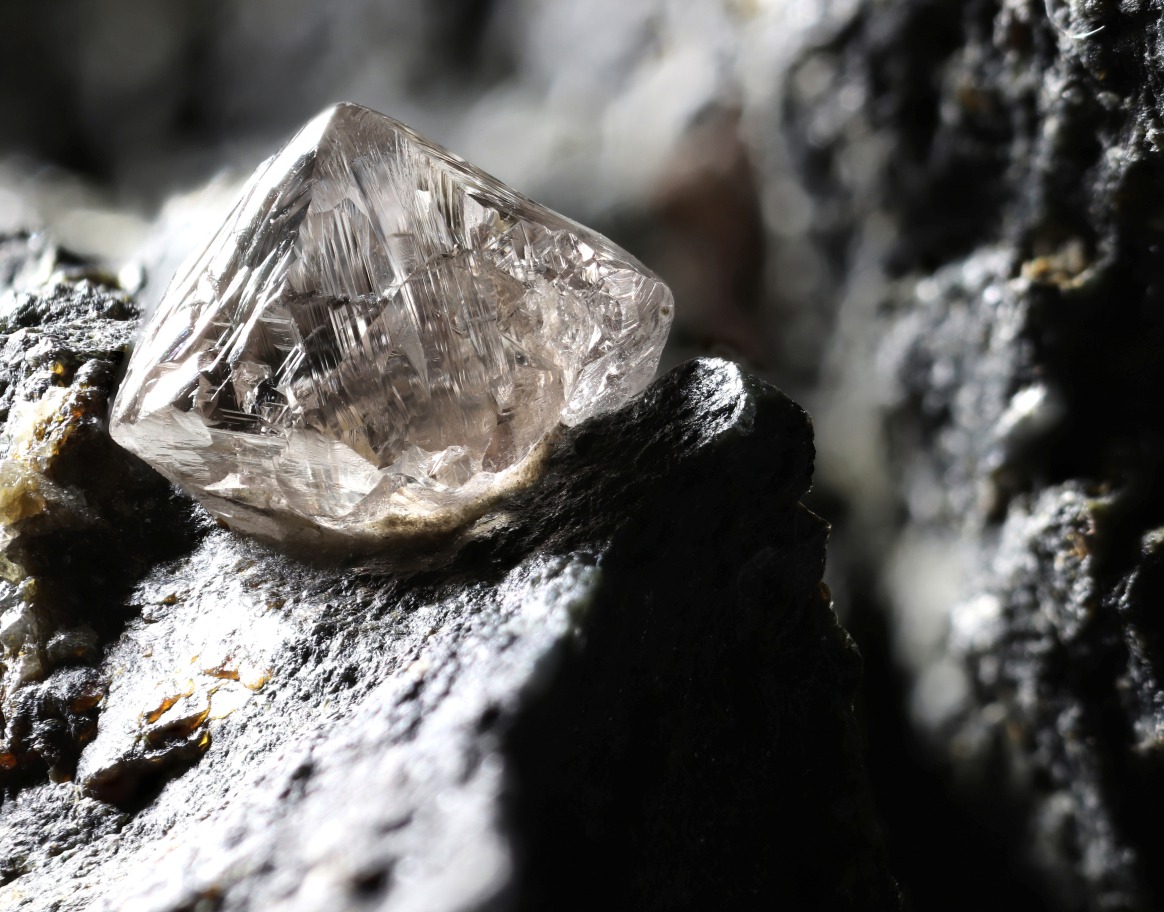
Planning the cut
With so much to think about when it comes to cutting gems, it’s pivotal to have this part of the process planned out in advance. Inclusions (cavities filled with fluid and/or gas) must be taken into account and removed if necessary, while ensuring colour banding and zoning is also balanced. Once the decision has been made, the gem will be cleaned and prepped.
Preshaping
During this phase, a freehand cutting will be done by a skilled cutter. They’ll take the rough and apply it to a “lap” (a large spinning wheel) which is laced with diamond powder. This will file down the gem to the basic shape of the desired final cut. Next, special wax is placed on the end of a metal rod called a “dop”, which is then attached to the pre-shaped gem.
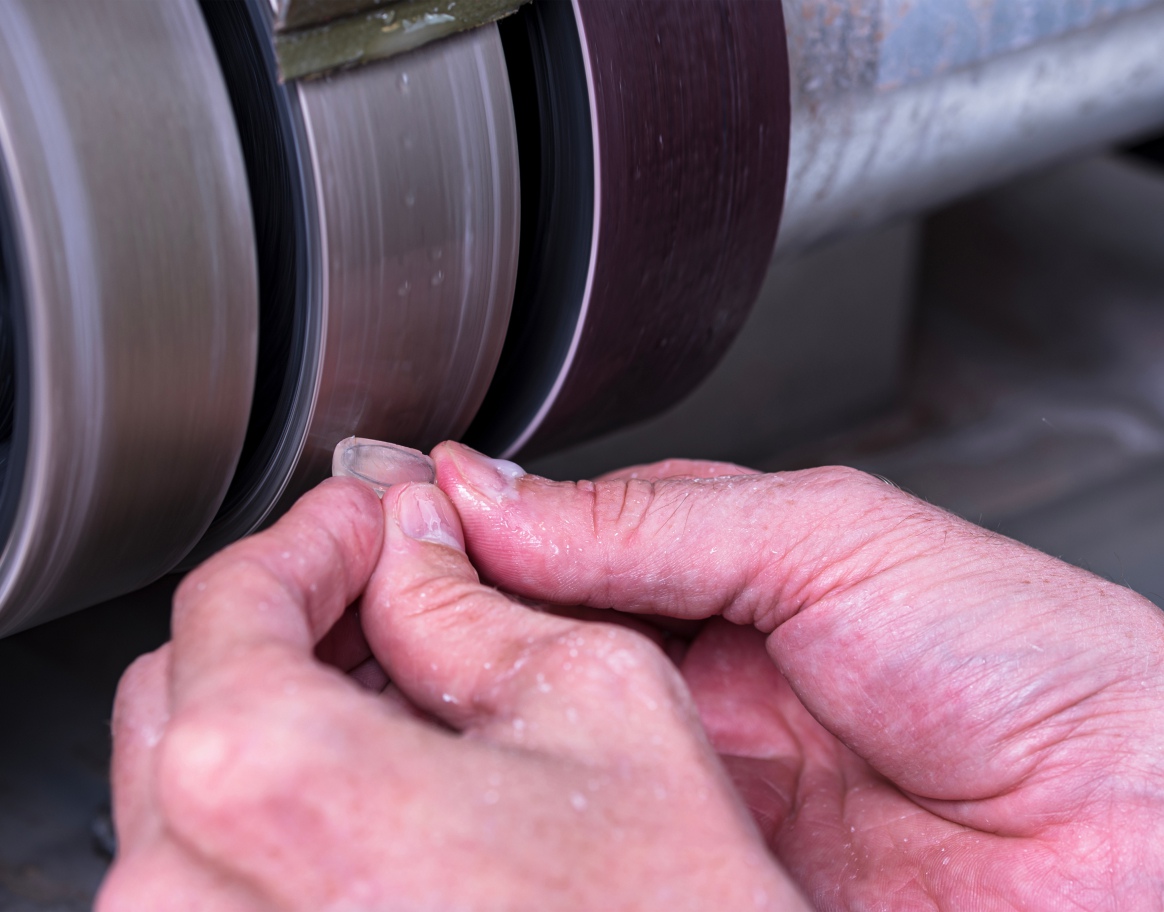
Faceting
The preshaping lap is replaced with a faceting one, with much finer diamond powder placed on it. A skilled cutter will then slowly and meticulously place the gem on this new lap, creating tens or even hundreds of faces (or facets) on the surface of the gemstone.
Cutters use a “Height, Angle, Index” triangle to precisely measure where each facet must be placed. “Height” determines the depth, “angle” the plane on which the cut takes place, and “index” the placement of facets around the overall shape. Specific angles will be used depending on the stone, as all gemstones reflect light differently.

Light leakage is checked
Poorly cut gems might result in the undesirable occurrence of light leakage. This effectively sees a window inadvertently cut into the gem, which allows a viewer to see through the centre of the piece. This is considered to be a major flaw in a cut gemstone.
Polishing
If the gem passes the light leakage test, the final step is to polish it. The third and final lap is attached at this point, with the finest diamond powder yet. An experienced cutter will slowly polish the gem at this stage to leave it with a breathtaking lustre that glimmers in any light.

Synthetic gems
While gems traditionally come from natural sources, technology has evolved to the point where creating lab-grown gemstones is now also a reality. Because these can be made to measure and are, in essence, unlimited in their supply, they tend to be less valuable. For this reason, sellers must always specify whether a gem is natural or grown in a laboratory.
There are six ways in which synthetic gems can be produced, with the first two mentioned here used exclusively for diamonds:
High Pressure High Temperature (HPHT)
This process recreates the natural environment in inner Earth, where a great amount of temperature and pressure is applied to a small ‘seed’ diamond encased in carbon. This heat and pressure persist for days until a larger diamond is formed.
Chemical Vapour Deposition (CVD)
This process sees diamonds grown using a hydrocarbon gas mixture. This mimics how a diamond might be formed in an interstellar gas cloud. A slice of diamond is placed in a sealed chamber and heated to 800 degrees celsius. Ionised carbon rich gases are then pumped in, which allows for carbon to merge with the diamond seed, helping it to grow.
Flame Fusion (Verneuil Process)
This was the first ever process used to successfully create synthetic gemstones. Powdered chemicals are dropped through a high-temperature flame, with the byproduct melting and falling onto a rotating pedestal. Despite being created as far back as 1883, this remains the most cost-effective and popular way to make synthetic gems.
Flux Growth
Flux is a soldering compound which, when melted, dissolves other materials in a similar fashion to how water dissolves salt and sugar. When a dissolved substance begins to cool, synthetic crystals form. This is a popular method for creating synthetic versions of precious gems — although it can take up to a year from start to finish, and the raw materials needed tend to be expensive.
Hydrothermal Growth
For this method to work, heat and pressure similar to the conditions found deep in the Earth are required. Nutrients are dissolved in a water solution and then exposed to these conditions, with the synthetic crystals forming during the cooling period.
Crystal Pulling (Czochralski Process)
This fascinating process sees key nutrients melted down in a crucible, with a seed crystal added to the mix. The new crystalline mineral grows around this, which are then pulled away and sold as individual gems.
Utilising these methods can result in a number of synthetic gems being artificially created. Some examples include:

Ruby
The first gem to be made using the Verneuil Process

Diamonds
HPHT or CVD processes largely deal with the production of diamonds

Sapphires
These are most commonly produced by flame fusion, but can also be flux grown

Emerald
These are usually produced via hydrothermal growth
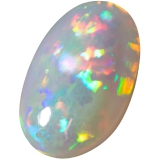
Opal
Hydrostatic pressure is usually used in the creation of these beautiful gems
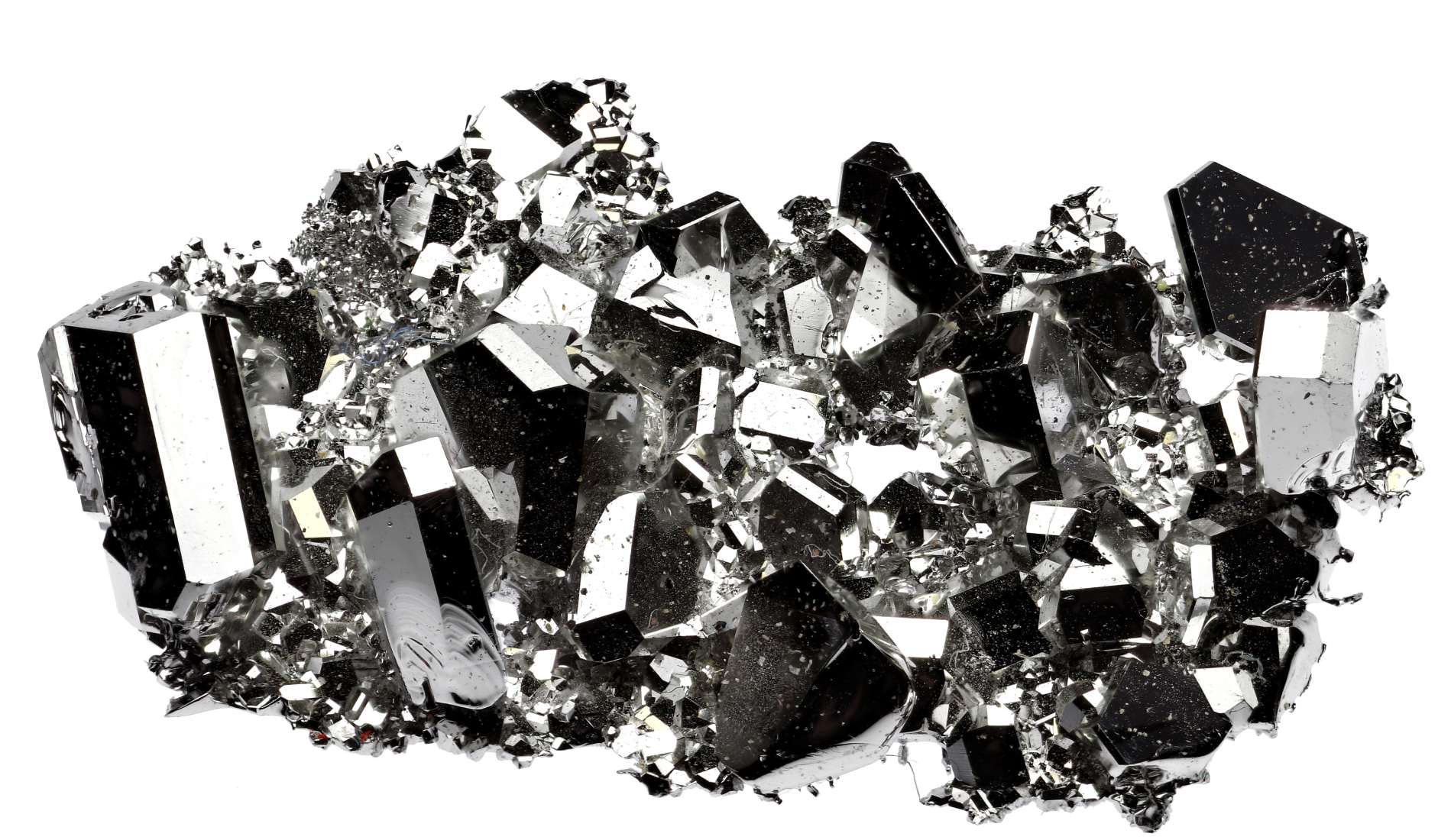
The modern use of gemstones

Gemstones in the modern age are less commonly associated with spiritual medicinal purposes — although this practice hasn’t been lost altogether. In this chapter, we’ll discuss what the current value of most major gemstones is, as well as jewellery types and spiritual connections which some believe the gems still have.
Modern gemstone values
Just as with any market, the value of specific gemstones tends to fluctuate in accordance with a number of key factors. For gems, these generally revolve around the following nine core principles:
1. Colour
The more rich or intense the colour of a gem, the higher valuation it will be given. We tend to associate certain gems with a vivid colour. For example, we all know emeralds are green and sapphires are most often blue. The closer to the natural royal blue or verdant green we associate the colour with, the better.
2. Clarity
Clarity doesn’t mean the ability to see through a gem, but rather a lack of inclusions (pockets of liquid or gas that are included within the stone). The fewer there are, the more value a gem carries.
3. Cut
A gem's value is greatly impacted by its cut level, that is, its capacity to sparkle and reflect light. The quality of the cut lies primarily in the hands of a cutter. It’s for this reason that experts who’ve spent decades honing their craft are called upon to work on precious gems.
4. Carat
While the finesse of the colour, clarity and cut are pivotal, it’s impossible to overlook the importance of how big or heavy a stone is. Gems are weighed in carats (0.2 grams). The total number of carats will define the intrinsic value of a gemstone.
5. Country of origin
Certain countries and even specific mines are famed for the quality of a particular stone they excavate. For example, countries like Myanmar, Sri Lanka, Colombia and Brazil tend to fetch high values for the gems they produce.
6. Shape
Some shapes cost more on the market than others. The rounder the shape, the more sought-after it tends to be. This is largely determined by the quantity of original rough stone lost during the cutting process.
7. Certificate
Having a gemstone certificate from an internationally recognized gemological laboratory will go a long way to increasing the value of a stone. These show that an item is legitimate, and act as a trust signal for potential buyers.
8. Treatment
If a gem has been artificially treated to change its colour, or any part of its appearance, it can often lower its value. Despite this being the case, treating stones are relatively common and well-accepted within the industry. However, the most prestigious gemstones on the market are usually untreated.
9. Supply chain
Just as with any commodity, the more steps along the supply chain, the higher you can expect the final price of an item to be. Gems are no different, with excavators, dealers, exporters, cutters and jewellers all taking a cut.
As a result, the amount that a gem can be valued at will be in a constant state of flux.
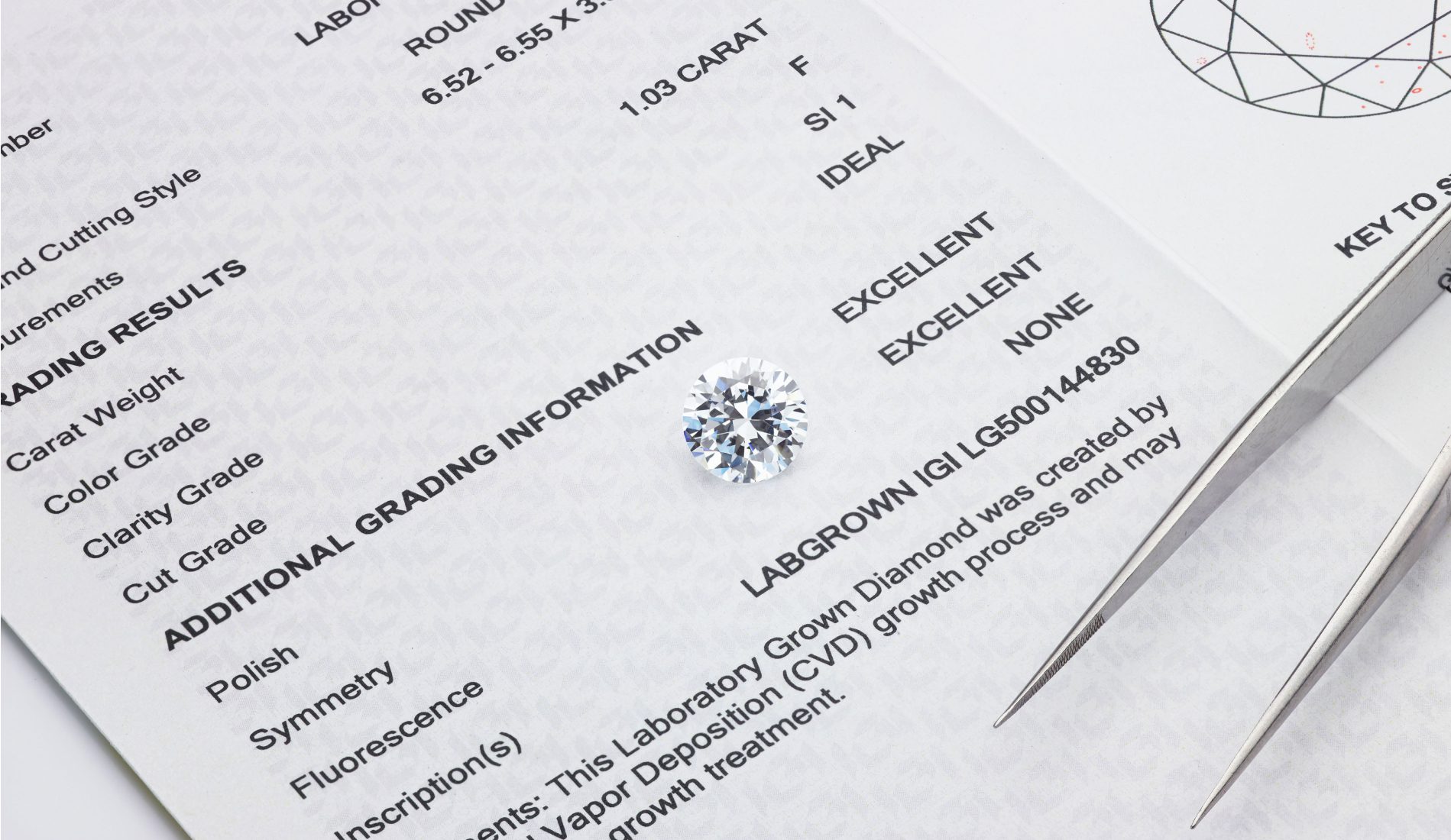
Birthstones and personalised jewellery
Everyone has a birthstone, even if they don’t know what theirs is. These associations with a coloured gem carry with them spiritual connections. Keeping your gem on you could help improve your luck, or even see you prosper in life.
Want to know what your birthstone is? Check out our full month-by-month breakdown here:

January
Garnet

February
Amethyst



March
Blue Topaz, Aquamarine or Bloodstone


April
White Topaz or Diamond


May
Chrysoprase or Emerald



June
Moonstone, Pearl or Alexandrite


July
Carnelian or Ruby

August
Peridot


September
Lapis Lazuli or Sapphire



October
Tourmaline, Rose Quartz or Opal


November
Smokey Quartz or Citrine


December
Turquoise or Tanzanite
Carrying around a gemstone in your pocket isn’t practical. As such, you’ll want to seamlessly blend your birthstone into your day-to-day look. Here are four ways to make your stone part of your aesthetic.
Bracelets
These pieces are versatile forms of jewellery. Your birthstone can be fixed all along the bracelet, or just in a focalised central point. Make sure to choose a metal which helps accentuate your gem’s natural brilliance.
Charm necklaces
Birthstones worn on a charm necklace are the ultimate way to customise your look while incorporating a stone that means something to you. The charm itself can be whatever you want it to be, which allows for a personal touch in regards to symbolism. Furthermore, the shape and design of the necklace will also give you more freedom when it comes to gem placement. Search around and look for inspiration online, or even come up with a totally unique design yourself.
Earrings
When one gem simply isn’t enough to leave you feeling satisfied, an earring set could be the way to go. This offers the chance to grab the attenton of onlookers no matter what angle they catch you from, and serves as the perfect way to make your birthstone an important, or even intrinsic, part of your look.
Pendants
Designed to evoke simplicity and grace, pendants are another fantastic way to show off your birthstone in a sleek and stylish manner. This type of jewellery often contains very little metal set around the gem, which ensures that the stone is the star of the show.
Rings
Gems work perfectly on a ring as they’re able to be incorporated fairly seamlessly into the metal itself. You can use a gem to create a solid band all the way round the outside of the ring, or use gem droplets to create individual patterns. Rings are also a great option for a birthstone because they offer the wearer the chance to make their gemstone the central feature.
Lockets
This practical item can be adorned with your gem on the clasp of the locket, allowing you to carry around a meaningful photo or other personal possession with you wherever you go. A locket can also serve as a cherished heirloom for future generations.

Healing or spiritual properties
Holistic medicine may not be as prevalent as it once was, but many still believe that gemstones carry with them healing and other-worldly properties that can help cure the mind, body and soul. Here are some examples of gems that are commonly used to heal or enhance your life:
Agate
Emotional, physical, and intellectual balance, harmonising yin and yang energies. It aids in centering physical energy, heals inner anger and encourages love to start over.
Alexandrite
This gemstone brings good luck, wealth and success. It might also increase self-esteem and confidence, while helping to manifest dreams and goals.
Amber
Amber enhances memory, helps with decision-making and improves mental agility. It brings good luck for warriors and is a talisman for self-confidence.
Amethyst
This gem is said to sooth dreams, while providing clarity and peacefulness to the waking mind. It also increases your intuition and psychic abilities.
Aquamarine
This gem helps maintain balance, while also improving courage and preparedness. It’s also thought to improve the luck of the wearer and promote feelings of joy and happiness.
Citrine
This orange gem brings abundance, optimism and happiness. It also cleanses your aura, promotes spiritual growth and aligns your energy with higher consciousness.
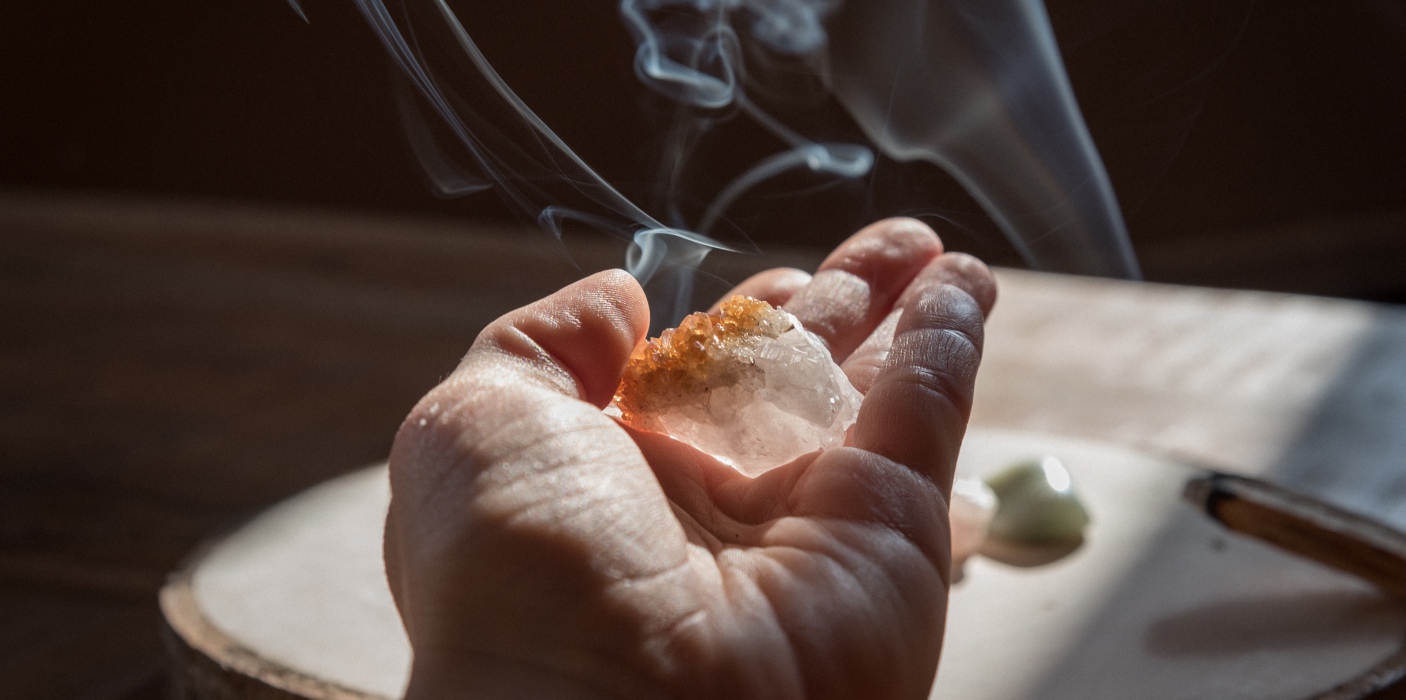
Diamond
Wearers of diamond will find that it calms the mind and brings peace. They also attract pleasure, romance and comfort.
Emerald
This vibrant green gem opens the heart to new possibilities and soothes your overall emotions. Inspiration, balance, wisdom and patience will also be heightened. Friendship, peace, harmony and domestic bliss may also be granted to a wearer.
Garnet
The red glow of garnet is often thought to increase sexual desire, while also believed to be a cure for melancholy, prevent haemorrhages and even improve circulation.
Jade
This brilliant green gem is used to heal emotionally, while also helping to quell and prevent nightmares. Jade may also bring good luck.

Labradorite
This gem serves as a shield for your aura, helping to protect against negativity. Labradorite also helps a person transform themselves, enhancing strength of will and inner worth.
Lapis lazuli
This gem is believed to help clear one’s throat, while also warding off physical attacks. Wisdom and communication skills are improved when wearing it.
Malachite
Those carrying this lesser-known gem can benefit from it revealing and healing emotional pain by absorbing the pain into itself. Malachite also provides the insight needed for growth.
Moonstone
This heavenly gem provides inner clarity and helps a wearer to embrace new beginnings. It’s also linked to themes like fertility, balance, softness, and intuition.
Opal
Opals help to boost your mood, while also providing peace. It can make clear what is or isn’t good for your life and help to remove negative elements surrounding you.
Pearl
Purity, balance and inner wisdom are at the forefront for wearers of pearl. They’re also thought to harmonise someone with the natural world.
Peridot
Peridot brings peace, health and rest. Creativity is also boosted and your general mood is likely to be cheerier when wearing it.
Rose Quartz
Rose Quartz is the stone of unconditional love. Compassion is heightened, as are your chances of finding a loving partner.
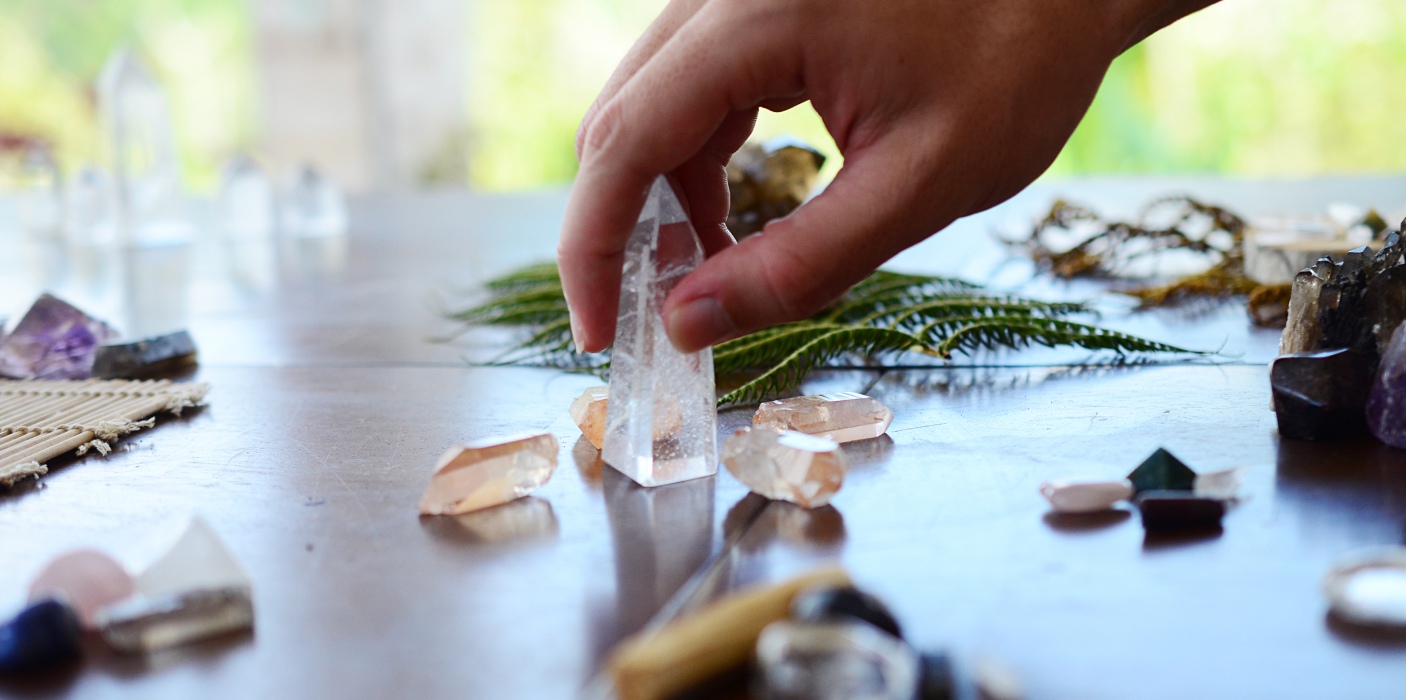
Ruby
This precious gem is thought to promote loving, nurturing, health, knowledge and wealth.
Sapphire
Also known as the wisdom stone, sapphire stimulates concentration and enhances creativity and depth of thought.
Topaz
Wearers of topaz will feel soothed, healed and re-centred. Many wear it when trying to build bridges with other people.
Tourmaline
This gem is perfect for those with a broken heart. It disperses emotional pain and dissolves disruptive feelings. Tourmaline can also calm negative emotions.
Useful Links
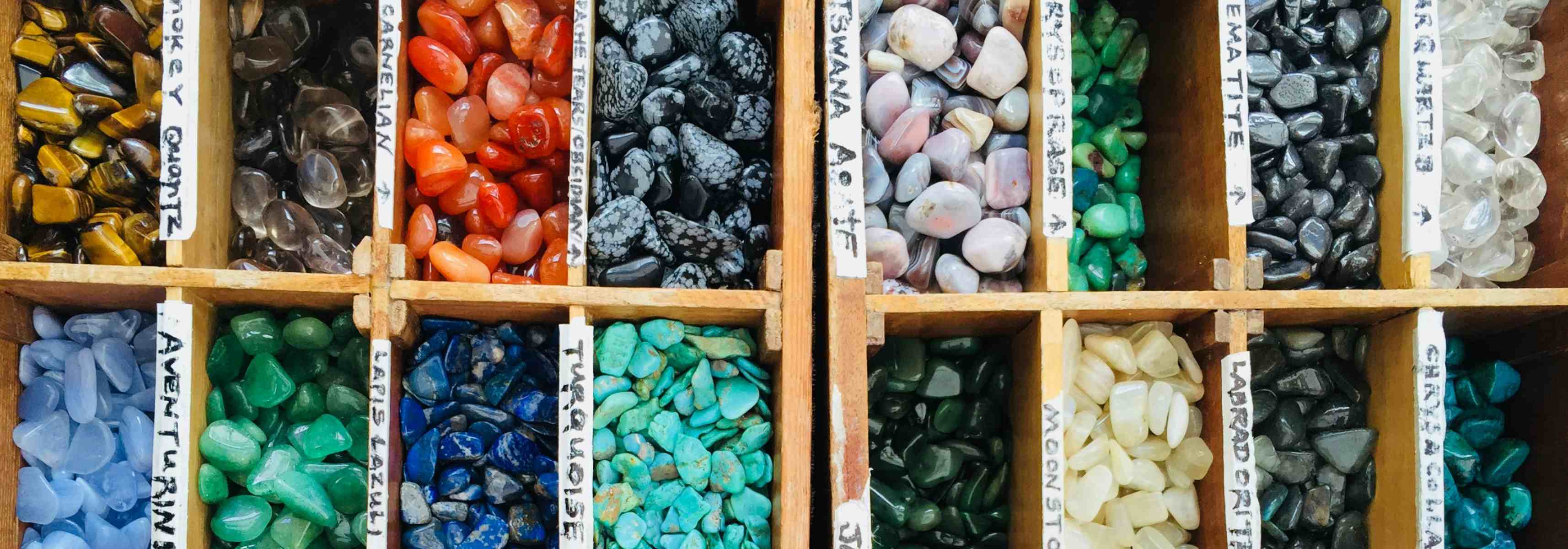
The world of gemstones is a mystical one. If you’d like to discover more about these aesthetically stunning minerals, be sure to check out this helpful collection of secondary reading materials.
-
Jewelry & Gemstone Cleaning Methods to Use at Home
https://www.americangemsociety.org/jewelry-gemstone-cleaning-methods/
-
The Most Comprehensive Guide to Buying Ethical Gemstones - Gem Breakfast
https://gembreakfast.com/blogs/news/the-most-comprehensive-guide-to-buying-ethical-gemstones
-
Sell your gemstones in London: Hatton garden best price
https://londongoldcentre.co.uk/gemstones/
-
List of Gemstones: Precious and Semi-Precious Stones - Gem Society
https://www.gemsociety.org/gemstone-encyclopedia/
-
Coloured Gemstone Guide - Discover Gemstones At 77 Diamonds
https://www.77diamonds.com/gemstones/guide





